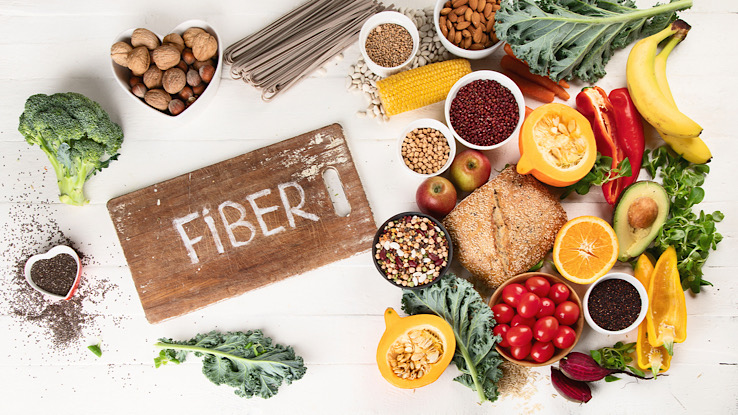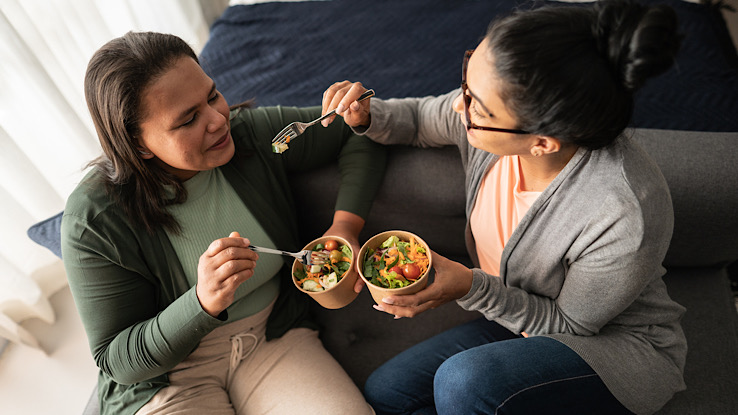
You’ve likely heard that fiber is an essential part of your diet. But what exactly is fiber, where can you get it, and why is it so important? If you’re looking to boost the fiber in your eating routine, or create your own high-fiber diet meal plan, start by reading this helpful guide. Learn more about fiber, what it does for your body, and how to easily incorporate it into your diet.
What Is Dietary Fiber?
Fiber is a type of carbohydrate found in plant foods that your body can’t fully digest or absorb as it does with other carbohydrates, fats, and proteins. However, it is essential for your body’s normal functioning and overall health as it passes through your digestive system and out of your body, aiding the whole process. Fiber is commonly classified into two types:
Soluble fiber
Soluble fiber dissolves in water or other fluids. In your body, soluble fiber attracts water, dissolves in it, and turns into a sort of gel. This helps slow down digestion and keep you feeling fuller for longer. Foods that are rich in soluble fiber include:
- oats
- peas
- beans
- apples
- citrus fruits
- carrots
- barley
- flaxseed
Insoluble fiber
Insoluble fiber does not dissolve in water or other fluids. Instead, it absorbs fluids in your body and sticks to other materials to form stool (poo). This process adds bulk to your stool and helps push other foods through your digestive system more quickly. This leads to softer, bulkier stools, more regular (and, let’s face it, more satisfying!). It can also prevent problems like constipation and hemorrhoids. Foods that are rich in insoluble fiber include:
- whole-wheat flour
- wheat bran
- nuts
- beans
- vegetables such as cauliflower, green beans, and potatoes
Why Is Dietary Fiber Important?
It might not sound right to eat something your body can’t absorb nutrients from. However, dietary fiber is important for your body’s regular functioning and keeps the digestive system healthy. There are a whole host of health benefits from including more fiber in your diet:
- Better bowel movements – Hey, everybody poos! And more fiber in your diet can help you have better, more regular bowel movements. Fiber improves digestion, regulates bowel movements, and prevents constipation. Whenever you feel a little backed up, add some fiber to your diet, and you’ll soon notice the difference.
- Healthy weight – Fiber-rich foods help you feel more full, so you are likely to eat less and stay satisfied for longer. This is very helpful for maintaining a healthy weight and why so many diets tell you to eat more plant-based foods that are high in fiber.
- Overall health – Eating more fiber helps lower cholesterol, control blood sugar levels, and reduce your risk of heart disease, stroke, type 2 diabetes, and some cancers.
- Gut health – You may have heard more and more about the importance of gut health and its effects on other parts of our body. In fact, the gut microbiota is a huge area of medical research to uncover exactly how it all works. However, for now, we know that feeding your body fiber introduces good bacteria into your gut. This can improve the functioning of your immune system and regulate your body’s energy balance.
- Mental health – a potential effect of improved gut health from eating more fiber is better mental health. This is known as the gut-brain axis, where what happens in your gut can create a chain reaction of internal biological processes that also play a role in your emotional and cognitive processing. This is connected to how you think and feel.
- Oral health – Foods rich in fiber often require you to chew for longer, which means your body produces more saliva. Saliva helps cleanse your teeth as you eat, so there is less chance of dental erosion. However, you will still need to brush your teeth regularly to maintain good oral health.
High-Fiber Diet Meal Plan
Increasing your fiber intake is easier when you know which high-fiber foods to eat. It is also important to get your fiber from various foods to ensure you are getting a good mix of all the other important nutrients as part of a healthy balanced diet. Below are some types of fiber sources and examples of foods that are rich in fiber for you to build into your daily meal plan:
Fruits
Fruits like raspberries, pears, apples, mangoes, and figs have fiber. They offer an easy way to get more fiber into your diet as you can build them into your breakfast. You can get this fiber in a smoothie, porridge, or yogurt. Remember that lots of fruits’ fiber are typically in their skin, so leave it on whenever possible to get the most benefits.
Vegetables
Vegetables like broccoli, brussel sprouts, potatoes, carrots, spinach, and kale have fiber. Making vegetables the base of your main meals is a great way to increase your fiber intake. Look for leafy greens, like kale, spinach, and chard, to use in salads or sauteed when you’re looking for high-fiber meal sides.
Whole grain foods & products
Whole grain products like brown rice, oats, rye, and quinoa have fiber. A whole grain is still in its full form and has been through the least amount of processing, and these have the most fiber. But you can also find whole grain and whole wheat cereals, pasta, & bread, which are also high in fiber.
Nuts, seeds, & legumes
Nuts, seeds, and legumes like almonds, chia seeds, peas, beans, and lentils have fiber. They make a great high-fiber snack or topping compared to other foods. Legumes can be incorporated into main meals to provide additional fiber content.
Boosting Your Fiber Gradually
It would be best to eat a certain amount of fiber daily as part of a healthy balanced diet. The recommended amount depends on the amount of food you should generally consume on a daily basis for your body’s energy needs, so this varies for children and adults, males and females:
- Under 5 years = 15g
- 5-11 years = 20g
- 11-16 years = 25g
- 16 years and older (female) = 21-25g
- 16 years and older (male) = 30-38g
Most people do not get enough fiber in their diet. If you want to increase the amount of fiber you are eating, make sure to do so slowly over a few weeks to give your body time to adjust to processing the higher fiber content. A sudden increase in fiber may lead to bloating, abdominal pain, and increased flatulence (gas/wind).
It would be best if you also try to stick to the recommended intake rather than going to extremes. A very high-fiber diet (more than 40g daily) could lead to you losing out on other important minerals (such as iron, zinc, and calcium). This can become bound to the insoluble fiber passing through your digestive system and then do not get absorbed and used as it should.
Can You Eat High Fiber and Low Carb?

Low-carb diets have many health benefits and can effectively lose weight or maintain a healthy weight range. However, some very low-carb diets can also be low in fiber content. The average person does not get enough fiber in their diet as is, so this is something to be mindful of when creating your healthy eating meal plan.
If you are trying to stick to a low-carb diet, there are plenty of great sources of fiber that are also low in carbs (based on 100g serving). Some of these include:
Fruits
- Avocado (carbs = 8.6g / fiber = 6.8g)
- Blackberries (carbs = 9.6g / fiber = 5.3g)
- Coconut meat (carbs = 15.2g / fiber = 9g)
Vegetables
- Kale (carbs = 4.4g / fiber = 4.1g)
- Eggplant (carbs = 5.8g / fiber = 3g)
- Broccoli (carbs = 6.6g / fiber = 2.6g)
- Cabbage (carbs = 5.8g / fiber = 2.5g)
Nuts & legumes
- Chia seeds (carbs = 42.1g / fiber = 34.4g)
- Flaxseeds (carbs = 28.9g / fiber = 27.3g)
- Almonds (carbs = 21.6g / fiber = 12.5g)
Should You Use a Fiber Supplement?
It is generally best to get your fiber from whole natural foods rather than powders and vitamin supplements. This is because fiber supplements (such as Metamucil, Citrucel, and FiberCon) don’t provide the variety of fibers, vitamins, minerals, and other nutrients that foods do.
However, some people may still need a fiber supplement if dietary changes aren’t sufficient or if they have certain medical conditions, such as constipation, diarrhea, or irritable bowel syndrome.
Before taking fiber supplements, you might consider eating foods that are fiber fortified, meaning they have some extra fiber added. If you’re still not seeing the health results you’re aiming for, such as less-frequent constipation, talk to your doctor about the possibility of taking fiber supplements.
Resource Links:
- “How to get more fibre into your diet” via NHS
- “Dietary fiber: Essential for a healthy diet” via Mayo Clinic
- “Chart of high-fiber foods” via Mayo Clinic
- “What is dietary fibre and is it beneficial?” via Eufic
- “Dietary Fibre” via Better Health
- “Fiber” via The Nutrition Source
- “Dietary fiber and health outcomes: an umbrella review of systematic reviews and meta-analyses” via The American Journal of Clinical Nutrition
- “The Health Benefits of Dietary Fibre” via Nutrients
- “Food Data Central” via US Department of Agriculture





